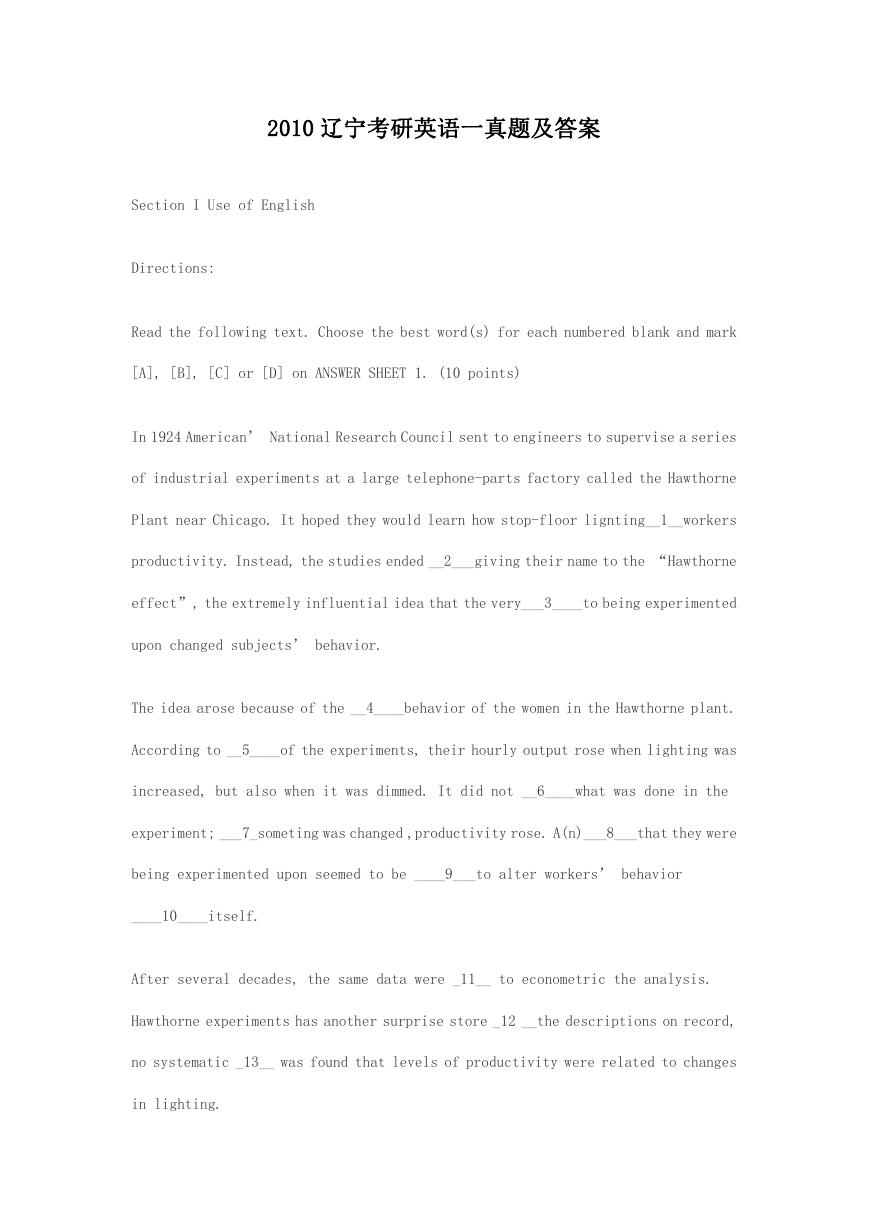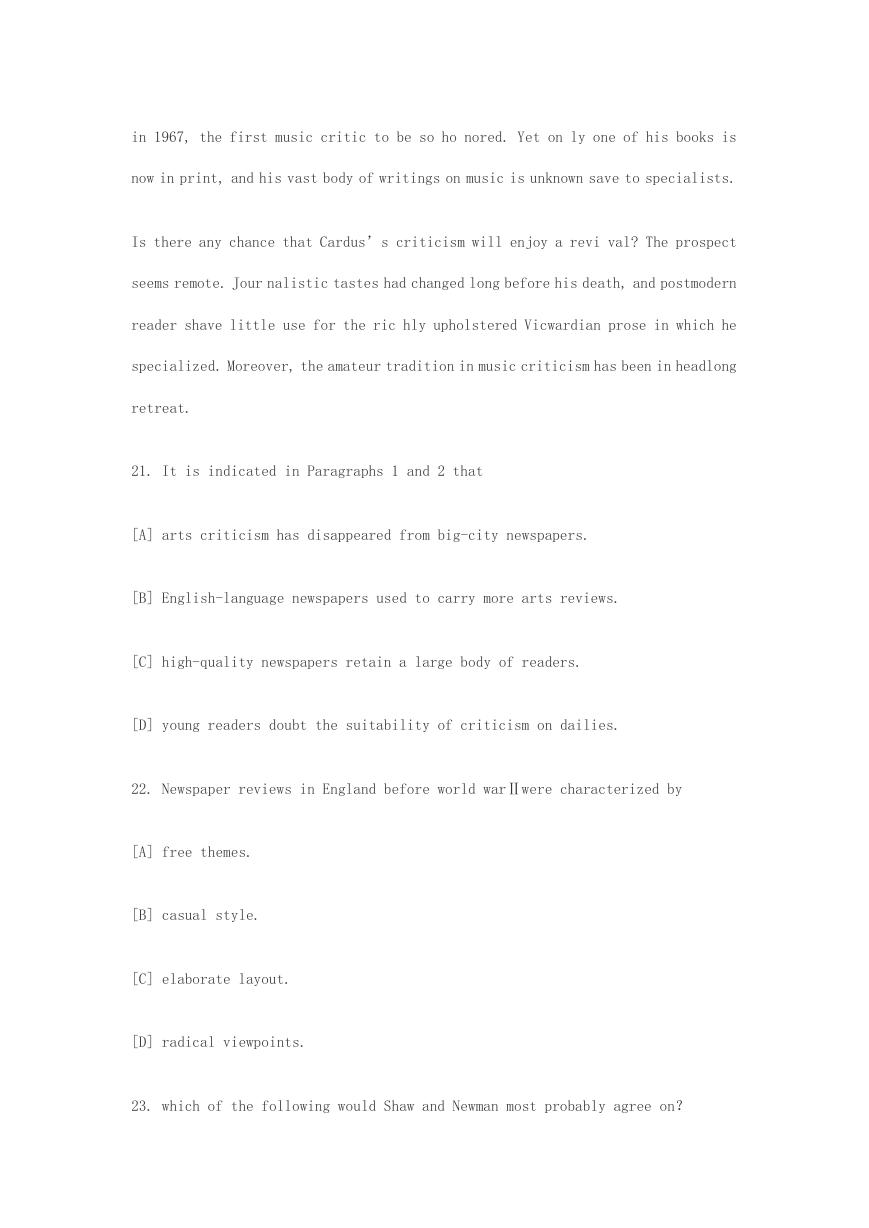2010 辽宁考研英语一真题及答案
Section I Use of English
Directions:
Read the following text. Choose the best word(s) for each numbered blank and mark
[A], [B], [C] or [D] on ANSWER SHEET 1. (10 points)
In 1924 American’ National Research Council sent to engineers to supervise a series
of industrial experiments at a large telephone-parts factory called the Hawthorne
Plant near Chicago. It hoped they would learn how stop-floor lignting__1__workers
productivity. Instead, the studies ended __2___giving their name to the “Hawthorne
effect”, the extremely influential idea that the very___3____to being experimented
upon changed subjects’ behavior.
The idea arose because of the __4____behavior of the women in the Hawthorne plant.
According to __5____of the experiments, their hourly output rose when lighting was
increased, but also when it was dimmed. It did not __6____what was done in the
experiment; ___7_someting was changed ,productivity rose. A(n)___8___that they were
being experimented upon seemed to be ____9___to alter workers’ behavior
____10____itself.
After several decades, the same data were _11__ to econometric the analysis.
Hawthorne experiments has another surprise store _12 __the descriptions on record,
no systematic _13__ was found that levels of productivity were related to changes
in lighting.
�
It turns out that peculiar way of conducting the experiments may be have let to__
14__ interpretation of what happed.__ 15___ , lighting was always changed on a
Sunday .When work started again on Monday, output __16___ rose compared with the
previous Saturday and__ 17 __to rise for the next couple of days.__ 18__ , a
comparison with data for weeks when there was no experimentation showed that output
always went up on Monday, workers__ 19__ to be diligent for the first few days of
the week in any case , before __20 __a plateau and then slackening off. This suggests
that the alleged” Hawthorne effect “ is hard to pin down.
1. [A] affected [B] achieved [C] extracted [D] restored
2. [A] at [B]up [C] with [D] off
3. [A]truth [B]sight [C] act [D] proof
4. [A] controversial [B] perplexing [C]mischievous [D] ambiguous
5. [A]requirements [B]explanations [C] accounts [D] assessments
6. [A] conclude [B] matter [C] indicate [D] work
7. [A] as far as [B] for fear that [C] in case that [D] so long as
8. [A] awareness [B] expectation [C] sentiment [D] illusion
9. [A] suitable [B] excessive [C] enough [D] abundant
10. [A] about [B] for [C] on [D] by
�
11. [A] compared [B]shown [C] subjected [D] conveyed
12. [A] contrary to [B] consistent with [C] parallel with [D] pealliar to
13. [A] evidence [B]guidance [C]implication [D]source
14. [A] disputable [B]enlightening [C]reliable [D]misleading
15. [A] In contrast [B] For example [C] In consequence [D] As usual
16. [A] duly [B]accidentally [C] unpredictably [D] suddenly
17. [A]failed [B]ceased [C]started [D]continued
20. [A]breaking [B]climbing [C]surpassing [D]hiting
Section II Reading Comprehension
Part A
Directions:
Read the following four texts. Answer the questions below each text by choosing [A],
[B], [C] or [D]. Mark your answers on ANSWER SHEET 1. (40 points)
Text 1
Of all the changes that have taken place in English-language newspapers during the
past quarter-century, perhaps the m ost far-reaching has been the inexorable decline
in the scope and seriousness of their arts coverage.
�
It is difficult to the point of impossibility for the average reader under the age
of forty to imagine a time when high-quality arts criticism could be found in most
big-city newspapers. Yet a considerable number of the most significant c ollections
of criticism published in the 20th century consisted in large part of new spaper
reviews. To read such books today is to marvel at the fact that their learned contents
were once deemed suitable for publication in general-circulation dailies.
We are even farther rem oved from the unfocused newspaper review spublished in
England between the turn of t he 2 0th century and the eve of World War Ⅱ, at a
time when newsprint was dirt-cheap and stylish arts crit icism was consi dered an
ornament to the publications in which it appe ared. In those far-off days, it was
taken for granted tha t the cri tics of major papers woul dwri te in detail and at
length about the events they covered. Theirs was a serious business, and even those
reviewers who wore their learning lightly, like George Bern ard Shaw and Ernest
Newman, could be trus ted to know what they were a bout. These men believed in
journalism as a calling, and were proud to be published in the daily press. “So
few authors have brains enough or literary gift enough to keep their own end up in
journalism, ”Newman wrote, “ that I am tempted to define‘journalism’ as ‘a term
of cont empt appl ied by writers who are not read to writers who are’. ”
Unfortunately, these critics are virtually forgotten. Neville Cardus, who wrote for
the Manchester Guardian from 1917 until shortly before his death in 1975, is now
known solely as a writer of essays ont he game of cricket. During his l ifetime,
though, he was also one of England's foremost classical-music critics, and a stylist
so widely admired that his Autobiography(1947)became a best-seller. He was knighted
�
in 1967, the first music critic to be so ho nored. Yet on ly one of his books is
now in print, and his vast body of writings on music is unknown save to specialists.
Is there any chance that Cardus’s criticism will enjoy a revi val? The prospect
seems remote. Jour nalistic tastes had changed long before his death, and postmodern
reader shave little use for the ric hly upholstered Vicwardian prose in which he
specialized. Moreover, the amateur tradition in music criticism has been in headlong
retreat.
21. It is indicated in Paragraphs 1 and 2 that
[A] arts criticism has disappeared from big-city newspapers.
[B] English-language newspapers used to carry more arts reviews.
[C] high-quality newspapers retain a large body of readers.
[D] young readers doubt the suitability of criticism on dailies.
22. Newspaper reviews in England before world warⅡwere characterized by
[A] free themes.
[B] casual style.
[C] elaborate layout.
[D] radical viewpoints.
23. which of the following would Shaw and Newman most probably agree on?
�
[A] It is writers’ duty to fulfill journalistic goals.
[B] It is contemptible for writers to be journalists.
[C] Writers are likely to be tempted into journalism.
[D] Not all writers are capable of journalistic writing.
24. What can be learned about Cardus according to the last two paragraphs?
[A] His music criticism may not appeal to readers today.
[B] His reputation as a music critic has long been in dispute.
[C]His style caters largely to modern specialists.
[D]His writings fail to follow the amateur tradition.
25. What would be the best title for the text?
[A] Newspapers of the Good Old Days.
[B] The lost Horizon in Newspapers.
[C] Mournful Decline of Journalism.
[D] Prominent Critics in Memory.
Text 2
�
Over the past decade, thousands of patents have been granted for what are called
business methods. Amazon.com received one for its“one-click”online payment system.
Merrill Lynch got legal protection for an asset allocation strategy. One inventor
patented a technique for lifting a box.
Now the nation’s top patent court appears completely ready to scale back on
business-method patents, which have been controversial ever since they were first
authorized 10 years ago. In a move that has intellectual-property lawyers abuzz the
U.S. court of Appeals for the federal circuit said it would use a particular case
to conduct a broad review of business-method patents. In re Bilski , as the case
is known , is “a very big deal”, says Dennis’D. Crouch of the University of Missouri
School of law. It “has the potential to eliminate an entire class of patents.”
Curbs on business-method claims would be a dramatic about-face, because it was the
federal circuit itself that introduced such patents with is 1998 decision in the
so-called state Street Bank case, approving a patent on a way of pooling mutual-fund
assets. That ruling produced an explosion in business-method patent filings,
initially by emerging internet companies trying to stake out exclusive pinhts to
specific types of online transactions. Later, move established companies raced to
add such patents to their files, if only as a defensive move against rivals that
might beat them to the punch. In 2005, IBM noted in a court filing that it had been
issued more than 300 business-method patents despite the fact that it questioned
the legal basis for granting them. Similarly, some Wall Street investment films armed
themselves with patents for financial products, even as they took positions in court
cases opposing the practice.
�
The Bilski case involves a claimed patent on a method for hedging risk in the energy
market. The Federal circuit issued an unusual order stating that the case would be
heard by all 12 of the court’s judges, rather than a typical panel of three, and
that one issue it wants to evaluate is whether it should” reconsider” its state
street Bank ruling.
The Federal Circuit’s action comes in the wake of a series of recent decisions by
the supreme Count that has narrowed the scope of protections for patent holders.
Last April, for example the justices signaled that too many patents were being upheld
for “inventions” that are obvious. The judges on the Federal circuit are “reacting
to the anti_ patent trend at the supreme court” ,says Harole C.wegner, a partend
attorney and professor at aeorge Washington University Law School.
26. Business-method patents have recently aroused concern because of
[A] their limited value to business
[B] their connection with asset allocation
[C] the possible restriction on their granting
[D] the controversy over authorization
27. Which of the following is true of the Bilski case?
[A] Its ruling complies with the court decisions
[B] It involves a very big business transaction
�
















 2023年江西萍乡中考道德与法治真题及答案.doc
2023年江西萍乡中考道德与法治真题及答案.doc 2012年重庆南川中考生物真题及答案.doc
2012年重庆南川中考生物真题及答案.doc 2013年江西师范大学地理学综合及文艺理论基础考研真题.doc
2013年江西师范大学地理学综合及文艺理论基础考研真题.doc 2020年四川甘孜小升初语文真题及答案I卷.doc
2020年四川甘孜小升初语文真题及答案I卷.doc 2020年注册岩土工程师专业基础考试真题及答案.doc
2020年注册岩土工程师专业基础考试真题及答案.doc 2023-2024学年福建省厦门市九年级上学期数学月考试题及答案.doc
2023-2024学年福建省厦门市九年级上学期数学月考试题及答案.doc 2021-2022学年辽宁省沈阳市大东区九年级上学期语文期末试题及答案.doc
2021-2022学年辽宁省沈阳市大东区九年级上学期语文期末试题及答案.doc 2022-2023学年北京东城区初三第一学期物理期末试卷及答案.doc
2022-2023学年北京东城区初三第一学期物理期末试卷及答案.doc 2018上半年江西教师资格初中地理学科知识与教学能力真题及答案.doc
2018上半年江西教师资格初中地理学科知识与教学能力真题及答案.doc 2012年河北国家公务员申论考试真题及答案-省级.doc
2012年河北国家公务员申论考试真题及答案-省级.doc 2020-2021学年江苏省扬州市江都区邵樊片九年级上学期数学第一次质量检测试题及答案.doc
2020-2021学年江苏省扬州市江都区邵樊片九年级上学期数学第一次质量检测试题及答案.doc 2022下半年黑龙江教师资格证中学综合素质真题及答案.doc
2022下半年黑龙江教师资格证中学综合素质真题及答案.doc